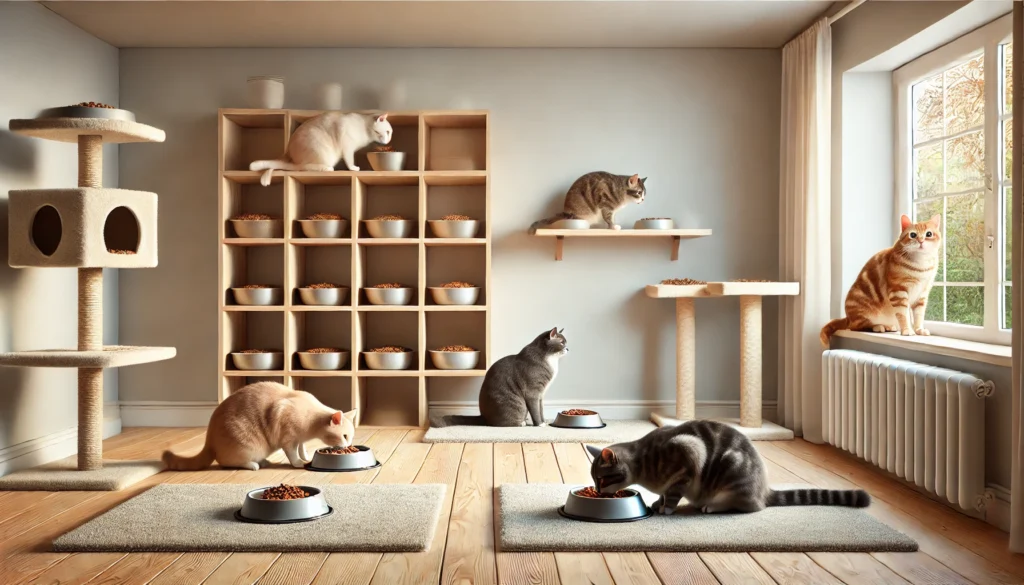Feeding time should be a peaceful part of the day, but in homes with multiple cats, it can easily turn into a source of tension. From food guarding to racing to the bowl, cats may feel stressed when eating together—especially if their space isn’t well organized.
Fortunately, a thoughtfully planned feeding station can reduce conflict, anxiety, and even improve digestive health. Here’s how to set up a calm, efficient multi-cat feeding area that works for everyone.
Understand Feline Feeding Behavior
Cats are solitary hunters by nature, not pack animals.
- Unlike dogs, they don’t instinctively eat together in groups.
- They prefer space, silence, and safety when eating.
- Being too close to other cats can trigger food anxiety or territorial behavior.
Understanding these instincts helps you set up a feeding area that respects their boundaries.
Give Each Cat Their Own Bowl
Sharing a bowl creates unnecessary competition.
- Always provide one bowl per cat—ideally more.
- Use wide, shallow bowls to prevent whisker fatigue.
- Place each bowl at a comfortable distance from the others.
Individual bowls promote peaceful mealtimes and give each cat control over their food.
Avoid Grouping Bowls in One Spot
Even if your cats seem to tolerate each other, avoid clustering bowls.
- Spread out feeding areas across the room or in separate rooms.
- Use furniture, corners, or shelves to create visual separation.
- Feeding cats side by side can lead to stress or silent bullying.
Cats appreciate personal space—even during meals.
Use Different Heights for Multi-Level Feeding
If space is tight, think vertically.
- Feed one cat on a counter, another on the floor.
- Use stable shelves or cat trees as feeding stations.
- This is especially helpful if one cat is slower and others try to steal food.
Multi-level setups provide both space and variety.
Feed on a Schedule, Not Free-Choice
Free-feeding can lead to overeating, weight gain, and food guarding.
- Set specific mealtimes for all cats (e.g., morning and evening).
- Remove uneaten food after 15–20 minutes.
- Scheduled meals reduce anxiety and allow you to observe behavior.
It also builds a sense of routine and anticipation.
Observe Each Cat’s Eating Behavior
Not all cats are equally assertive.
- Some may wait until others finish before eating.
- Others may guard or block access to food.
- One cat may consistently finish others’ bowls.
Keep an eye out for subtle tension and adjust setup as needed.
Consider Microchip or RFID Feeders
For cats on different diets or who steal from others, high-tech solutions help.
- Microchip feeders only open for the assigned cat.
- Ideal for homes with prescription diets or weight management needs.
- They also ensure shy or slow eaters get their full portion.
While more expensive, they offer peace of mind in complex feeding situations.
Keep the Area Clean and Calm
A clean, quiet space encourages healthy eating.
- Choose a low-traffic area of the house.
- Keep bowls, mats, and floors clean to prevent odor buildup.
- Avoid feeding near litter boxes or noisy appliances.
A hygienic environment improves appetite and digestion.
Use Visual Cues to Reduce Tension
Cats are territorial, but you can manage territory through setup.
- Use placemats or colored bowls to visually define eating spots.
- Separate feeding areas with furniture or low barriers.
- Maintain consistency in placement to reinforce security.
Clear boundaries help reduce subtle competition.
Reward Calm Mealtime Behavior
Positive associations lead to long-term success.
- Offer a treat or praise after a calm meal session.
- Avoid creating urgency—keep your energy relaxed.
- If necessary, use slow feeder bowls to pace fast eaters.
Creating a peaceful mealtime environment reinforces good behavior.
Adjust and Reassess Regularly
Cats change over time, and so should your setup.
- Monitor how each cat behaves during meals.
- Adjust spacing or locations as new cats are added.
- Be flexible with tools and strategies—each cat is unique.
What works today may need a tweak tomorrow.
With a little planning, feeding time can go from chaotic to calm. By respecting each cat’s individual space and instinct, you’ll support their emotional health, reduce conflict, and make daily routines smoother for everyone.






